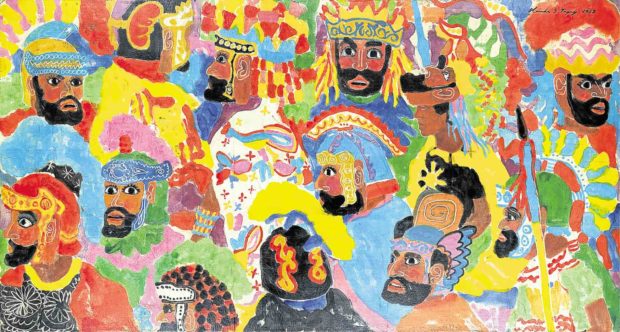ANGELES CITY, Pampanga, Philippines —“Drawing and painting are a child’s play.”
That was Claude Tayag talking quite fast and candidly, sharing with about 70 young artists a lesson he learned in life.
In that large, well-lit room surrounded by the studies and black-and-white photographs of National Artist Vicente Manansala at Holy Angel University (HAU) here, Tayag echoed Pablo Picasso’s words: “Every child is an artist. The problem is how to remain as an artist once we grow up.”
He surely stayed as one. At 63, he has produced about 500 paintings from 1974 to present, sculpted wood into many furniture pieces, and cooked like, in his own word, a “kusinero” (cook).
PARTNERS Claude Tayag and wife Mary Ann Quioc are perfect partners in the culinary and visuals arts scene. —TONETTE OREJAS
The young audience also got this advice from him: “Do not lose that child in you. You will encounter many forks in your personal journey. But, always listen to you heart, and your art will guide you.”
In a sense, he was generous with his retrospective watercolor exhibit at the National Museum of Fine Arts, having featured 125 of his works until Sept. 22.
But Tayag looked extra generous to young Kapampangan artists, interacting with them for two hours before he opened his recent exhibit of 60 watercolor paintings at HAU.
No to gadgets
They were somewhat shocked when he blurted what was a no-no to millennials: “No to gadgets. Or at least minimize your dependency on [these].”
Although the Tayag family belonged to the upper-middle class, he grew up without a television in the house and store- bought toys, and traveled around Europe without a camera.
“Write your thoughts longhand or cursive. Better yet doodle if you can. Live the moment. Go out and smell the roses. Savor the food on your plate. Watch a concert with your eyes and not through a 3-inch screen on your phone. Be less and less dependent on your gadgets,” he said.
Tayag decided to be a painter when he was 12 years old, right after seeing his father, lawyer Renato “Katoks” Tayag, writer Emilio “Abe” Aguilar Cruz, Sofronio “SYM” Mendoza, Romulo Galicano, Rodolfo Ragodon, Andres Cristobal Cruz, Mauro “Malang” Santos and Manansala paint together the Zambales mountain ranges as viewed from what is now the Carmenville Subdivision here.
The book, ”Claude Tayag: A Watercolor Journey,” accompanied the two exhibits that Ana Labrador, National Museum assistant director, broached during E. Aguilar Cruz’s exhibit two years ago.
Popular as chef
Tayag was not asserting anything in his book, though he is more popular as a chef and author of culinary books. He admitted that he got this cooking side of him from his mother, Adoracion, who raised four girls and eight boys, with Tayag being the ninth in the brood. His father, banker-cum-writer Katoks, inspired his love for painting.
The book, he said, simply showed the length and volume of his works, as written about by Alice G. Guillermo, Esperanza Bunag Gatbonton, Rod Paras-Perez and Alejandro R. Roces.
At the HAU exhibit, Tayag pulled a guest toward “Kain Na,” one of his watercolor paintings of the lake-dwelling T’boli people in Lake Sebu in 2007.
“Look at her wonderful smile and the ‘suman’ (native rice cake) she wanted to share with you,” he said, like a child, indeed.
